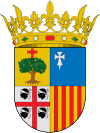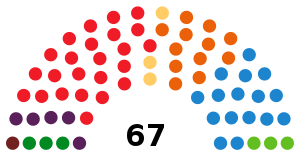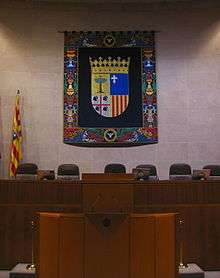Aragonese Corts
The Aragonese Corts (Spanish: Cortes de Aragón, Aragonese: Cortz d'Aragón, Catalan: Corts d'Aragó) is the regional parliament for the Spanish autonomous community of Aragon. The Corts traces its history back to meetings summoned by the Kings of Aragon which began in 1162. Abolished in 1707, the Corts were revived in 1983 following the passing of a Statute of Autonomy.
Aragonese Corts Cortes de Aragón | |
|---|---|
| Aragon unicameral legislature | |
 | |
| Type | |
| Type | |
| Houses | Unicameral |
| Leadership | |
Vice President | |
Second Vice President | |
Secretary | |
Second Secretary | |
| Structure | |
| Seats | 67 |
 | |
Political groups | Government (35)
Opposition (31) |
Length of term | 4 years |
| Elections | |
Last election | 26 May 2019 |
| Meeting place | |
| Aljafería Palace, modern location of the Aragonese Parliament or Corts. | |
Early Corts
The King of Aragon was bound to summon the Corts at least once every five years, and, following the union with Catalonia, annually.[1] The main business of the Corts was judicial: solving disputes between individuals or towns or dealing with complaints or grievances concerning the King's officers or Estates.[1] The Corts also approved legislation and voted on tax issues.[1] The Corts was organised into four Estates or branches: the clergy, the great nobles (Spanish: Ricos hombres), the Knights and the towns.[2]
For the more important laws, unanimity was required between each of the Corts' four Estates (nemine descriptante).[1] Each member could veto any law, in which case the decision would be recorded as unamiter excepto N.N. which allowed for further debates and discussions, although these too often ended in stalemates with no agreement being reached.[1] In such cases, the decision was referred to a permanent committee which consisted of two representatives of each Estate who would judge whether the existing majority will was sound or not.[1] These Corts were the model for the parliaments of Sardinia and Sicily.[1] The Corts survived until 1707 when Philip V issued the Nueva Planta decrees, centralising political power and abolishing the former regional assemblies of the Crown of Aragon.
Current Corts

The modern Corts were established in 1983 under Article 12 of the Statute of Autonomy for Aragon.[3] This statute also sets out the functions of the Aragonese assembly in Article 16 and these include the election of the President of Aragon, approving the actions and legislation of the President, creating legislation, amending the Constitution of Aragon and supervising any relevant planning or economic projects. It must monitor borrowing and spending and appoint an Auditor General for Aragon. Additionally the legislature must elect the appropriate number of Senators to serve in the Spanish Senate.[3]
Speakers of the Corts
Party strength (1983-present)
Below is a summary of election results from the first Corts election to the present. The largest party after each election is denoted in bold.
| Party | 1983 | 1987 | 1991 | 1995 | 1999 | 2003 | 2007 | 2011 | 2015 | |
|---|---|---|---|---|---|---|---|---|---|---|
| PSOE | 33 | 27 | 30 | 19 | 23 | 27 | 30 | 22 | 18 | |
| PP | 18 | 13 | 17 | 27 | 28 | 22 | 23 | 30 | 21 | |
| PAR | 13 | 19 | 17 | 14 | 10 | 8 | 9 | 7 | 6 | |
| CHA | - | - | - | 2 | 5 | 9 | 4 | 4 | 2 | |
| IUA | 1 | 2 | 3 | 5 | 1 | 1 | 1 | 4 | 1 | |
| P's | - | - | - | - | - | - | - | - | 14 | |
| C's | - | - | - | - | - | - | - | - | 5 | |
| CDS | 1 | 6 | - | - | - | - | - | - | - | |
Presidents and Governments of Aragon
References
- Colomer, Josep Maria (2003). Political Institutions: Democracy and Social Choice. Oxford University Press. p. 77. ISBN 978-0-19-924184-2. Retrieved 2009-08-09.
- Marriott, John Arthur Ransome (1970). This Realm of England; Monarchy, Aristocracy, Democracy. Ayer Publishing. p. 108. ISBN 978-0-8369-5611-5. Retrieved 2009-08-09.
- "Aragonese Statute of Autonomy". Archived from the original on 2011-07-22. Retrieved 2009-08-09.